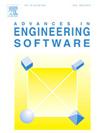Research and implementation of an online platform for efficient and accurate ship hull design
IF 5.7
2区 工程技术
Q2 COMPUTER SCIENCE, INTERDISCIPLINARY APPLICATIONS
引用次数: 0
Abstract
Motivation
With the development of computer graphics in front-end technology and internet applications, there are many universal online modeling tools like Spline and Vectary. However, ship hull design requires specific constraints like displacement volume and standard deformation algorithms such as Lackenby and Free-Form deformation (FFD).
Solution
This study developed an online platform of ship hull parametric modeling and design called Ship Hull Iterative Parametrization Online (SHIP Online). Firstly, three deformation methods—linear,interactive FFD, and combined deformation—were implemented using JavaScript and Python. Fast Quadric Mesh Simplification (FQMS) and Nelder-Mead optimization were introduced for combined deformation. Secondly, the user interface was built with HTML5, JavaScript, and CSS. Thirdly, the synchronization and data transmission issues between front and back-end were handled by Django and $. ajax. Finally, the platform would be deployed on a cloud server for multi-system access.
Result
The DTMB-5415 standard model was used to evaluate the accuracy, efficiency, and functions of calculations and deformations in SHIP Online. The errors of hydrostatic parameters were nearly 0.0 %. With a 90 % optimal simplification rate and parameter errors under 0.001, combined deformation efficiency improved by 87.78 % and 55.15 % compared to deformation without FQMS and other software. Functional and user testing shows that the functions can be stably and normally executed.
Conclusion
By integrating ship deformation algorithms and design constraints with the front-end technology, SHIP Online provides a Web-based rapid hull design platform instead of traditional 3D modeling client software.
高效、准确船体设计在线平台的研究与实现
随着计算机图形学在前端技术和互联网应用方面的发展,出现了许多通用的在线建模工具,如Spline和vector。然而,船体设计需要特定的约束,如排水量和标准变形算法,如Lackenby和Free-Form deformation (FFD)。本研究开发了一个船体参数化建模与设计的在线平台——船体迭代参数化在线(ship online)。首先,利用JavaScript和Python实现了线性、交互式FFD和组合变形三种变形方法。引入快速二次网格简化(FQMS)和Nelder-Mead优化方法求解组合变形。其次,用户界面是用HTML5、JavaScript和CSS构建的。第三,前台和后台之间的同步和数据传输问题由Django和$来处理。ajax。最后,该平台将部署在云服务器上,用于多系统访问。结果采用DTMB-5415标准模型对SHIP Online中计算和变形的准确性、效率和功能进行了评价。流体静力参数的误差接近0.0%。在优化简化率为90%、参数误差小于0.001的情况下,变形效率分别比不使用FQMS和其他软件的变形效率提高了87.78%和55.15%。功能和用户测试表明,该功能可以稳定、正常地执行。ship Online将船舶变形算法和设计约束与前端技术相结合,提供了一个基于web的快速船体设计平台,取代了传统的3D建模客户端软件。
本文章由计算机程序翻译,如有差异,请以英文原文为准。
求助全文
约1分钟内获得全文
求助全文
来源期刊

Advances in Engineering Software
工程技术-计算机:跨学科应用
CiteScore
7.70
自引率
4.20%
发文量
169
审稿时长
37 days
期刊介绍:
The objective of this journal is to communicate recent and projected advances in computer-based engineering techniques. The fields covered include mechanical, aerospace, civil and environmental engineering, with an emphasis on research and development leading to practical problem-solving.
The scope of the journal includes:
• Innovative computational strategies and numerical algorithms for large-scale engineering problems
• Analysis and simulation techniques and systems
• Model and mesh generation
• Control of the accuracy, stability and efficiency of computational process
• Exploitation of new computing environments (eg distributed hetergeneous and collaborative computing)
• Advanced visualization techniques, virtual environments and prototyping
• Applications of AI, knowledge-based systems, computational intelligence, including fuzzy logic, neural networks and evolutionary computations
• Application of object-oriented technology to engineering problems
• Intelligent human computer interfaces
• Design automation, multidisciplinary design and optimization
• CAD, CAE and integrated process and product development systems
• Quality and reliability.
 求助内容:
求助内容: 应助结果提醒方式:
应助结果提醒方式:


